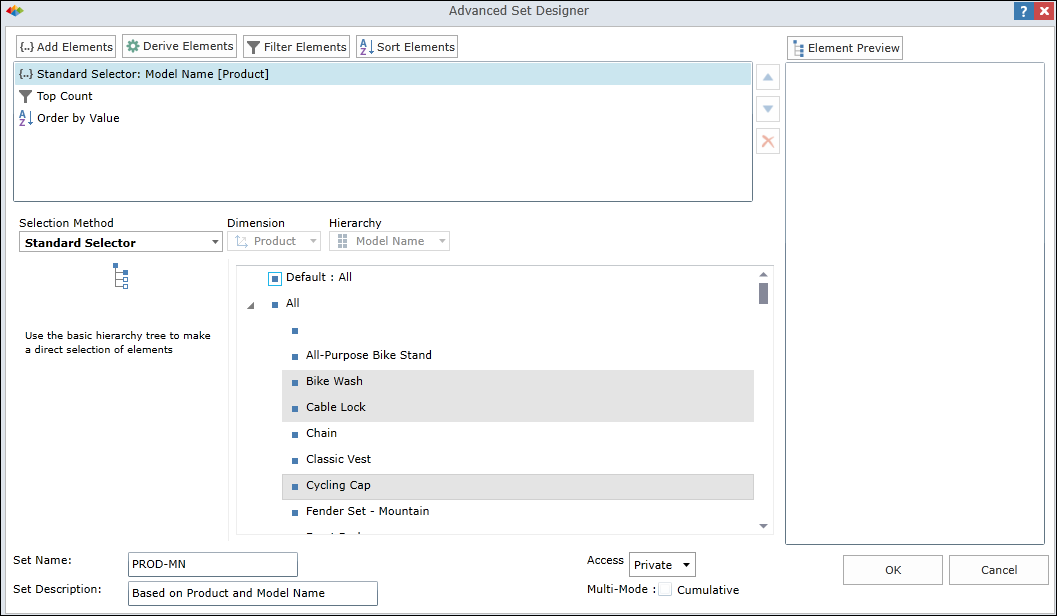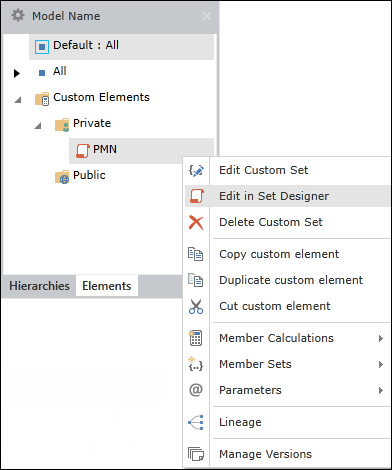Advanced Set Designer (ASD)
This page contains the following sections:
- Intro to ASD
- Accessing ASD
- ASD Script Box
- ASD Quick Instructions
- ASD Sets vs. Custom Element Sets
- Parameters within ASD Sets
Intro to ASD
The Advanced Set Designer (ASD) is a powerful design tool that allows users to build complex sets of elements that can be incorporated within queries - without the need to write any MDX code.
An unlimited number of steps can be added, customized and sequenced for the selection of hierarchy elements to be used in queries. In addition, variables, variable sets and parameters may be integrated within ASD scripts to create flexible user-driven sets.
See the ASD Example for step-by-step instructions for building an ASD set.
Accessing ASD
To open the Advanced Set Designer, click Set Designer in the Data Discovery/Analytics ribbon.

The main ASD dialog is shown below. You can use this dialog to enter a series of steps that comprise the set script.

ASD Script Box
The ASD script box is the place where you add one or more elements to your ASD set.
- Each line in the script box represents a logical step in the ASD set.
- The steps are executed sequentially - from top to bottom.
- Use the up/down buttons to reorder the steps.
- Use the delete button to remove a step.
- When beginning a new ASD set, only the Add Elements button is active. You use the Add Elements button to enter the very first element which may be a Standard Selector or a Switch Selector. Afterwards, all four of the element buttons are active and you can use the four in any desired order.
- There is no limit to the number of steps you may enter. But from a practical standpoint, you should try to use as few as possible to keep the logic simple.

ASD Quick Instructions
To create an ASD set of elements, follow these steps.
a) Click Add Elements to start the creation of an ASD set.
b) Choose a Selection Method:
- Standard Selector - Direct selection of elements from a hierarchy.
- Switch Selector - Switchable selection of elements from a hierarchy (by means of a variable or variable set or parameter).
c) Choose desired Dimension and Hierarchy.
d) Select desired elements in tree.
e) Click Element Preview to view all selected elements. (optional)
f) Add additional steps using:
- Add Elements
- Derive Elements
- Filter Elements
- Sort Elements
g) Type in a Set Name.
h) Type in a Set Description. (optional)
i) Set Access rights as Private or Public. Your selection influences whether the ASD set is stored in the Custom Elements/Private or Custom Elements/Public folder. For related info, read about Roles and Security rights.
j) Leave Multi-Mode unchecked.
k) Click OK to create ASD set.
ASD Sets vs. Custom Element Sets
ASD sets appear in the Custom Elements folder under that particular hierarchy in which they were created. Right click on an ASD set to display relevant commands:
- Edit Custom Set - Open the Custom Set dialog and edit the ASD set in the same manner as any custom set. Just be aware that once you make changes within the Custom Set editor, the "ASD set" is converted to a "custom set" and you can no longer load the set into the ASD editor.
- Edit in Set Designer - Open the ASD set to make further changes.
- Delete Custom Set - Delete the ASD set from the Custom Elements folder.

Parameters within ASD Sets
One of the more powerful analytic features of Data Discovery relates to using parameters inside ASD sets. Inclusion of parameters allows users to change the definitional construct of an ASD set at run time by using parameter slicers - rather than having to manually edit values within the ASD definition itself.
For instance, assume a user wishes to create a list of the top 10 customers using a selection of "bikes" from the product hierarchy, and a selection of "quantity" from the measures hierarchy.
The user wants to choose the product and measure interactively, so that the list of the top 10 customers changes at runtime based on the user's selection. Instead of hard-coding the selections of "bikes" and "quantity", the ASD designer can instead use a product hierarchy parameter list and a measure hierarchy parameter list. When the ASD set appears in a query, the user will be prompted to select a product and measure to generate the top 10 customer list based on the current selections.
Home |
Table of Contents |
Index |
User Community
Pyramid Analytics © 2011-2022

